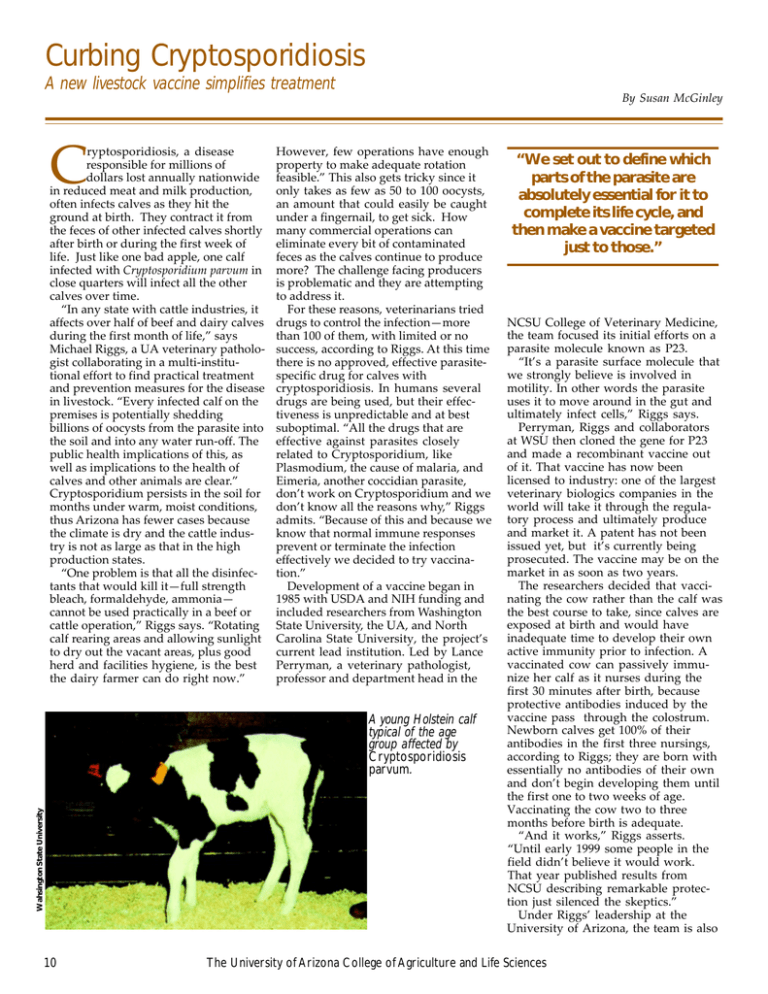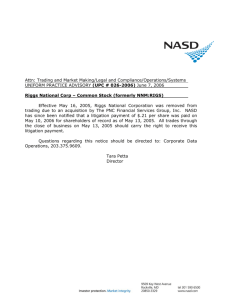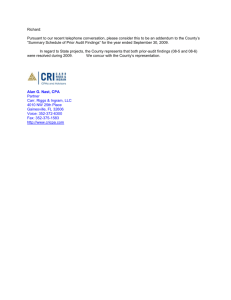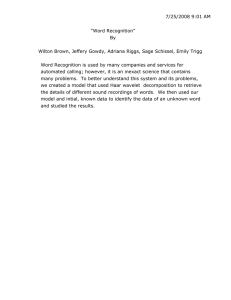C Curbing Cryptosporidiosis A new livestock vaccine simplifies treatment
advertisement

Curbing Cryptosporidiosis A new livestock vaccine simplifies treatment C ryptosporidiosis, a disease responsible for millions of dollars lost annually nationwide in reduced meat and milk production, often infects calves as they hit the ground at birth. They contract it from the feces of other infected calves shortly after birth or during the first week of life. Just like one bad apple, one calf infected with Cryptosporidium parvum in close quarters will infect all the other calves over time. “In any state with cattle industries, it affects over half of beef and dairy calves during the first month of life,” says Michael Riggs, a UA veterinary pathologist collaborating in a multi-institutional effort to find practical treatment and prevention measures for the disease in livestock. “Every infected calf on the premises is potentially shedding billions of oocysts from the parasite into the soil and into any water run-off. The public health implications of this, as well as implications to the health of calves and other animals are clear.” Cryptosporidium persists in the soil for months under warm, moist conditions, thus Arizona has fewer cases because the climate is dry and the cattle industry is not as large as that in the high production states. “One problem is that all the disinfectants that would kill it—full strength bleach, formaldehyde, ammonia— cannot be used practically in a beef or cattle operation,” Riggs says. “Rotating calf rearing areas and allowing sunlight to dry out the vacant areas, plus good herd and facilities hygiene, is the best the dairy farmer can do right now.” By Susan McGinley However, few operations have enough property to make adequate rotation feasible.” This also gets tricky since it only takes as few as 50 to 100 oocysts, an amount that could easily be caught under a fingernail, to get sick. How many commercial operations can eliminate every bit of contaminated feces as the calves continue to produce more? The challenge facing producers is problematic and they are attempting to address it. For these reasons, veterinarians tried drugs to control the infection—more than 100 of them, with limited or no success, according to Riggs. At this time there is no approved, effective parasitespecific drug for calves with cryptosporidiosis. In humans several drugs are being used, but their effectiveness is unpredictable and at best suboptimal. “All the drugs that are effective against parasites closely related to Cryptosporidium, like Plasmodium, the cause of malaria, and Eimeria, another coccidian parasite, don’t work on Cryptosporidium and we don’t know all the reasons why,” Riggs admits. “Because of this and because we know that normal immune responses prevent or terminate the infection effectively we decided to try vaccination.” Development of a vaccine began in 1985 with USDA and NIH funding and included researchers from Washington State University, the UA, and North Carolina State University, the project’s current lead institution. Led by Lance Perryman, a veterinary pathologist, professor and department head in the Wahsington State University A young Holstein calf typical of the age group affected by Cryptosporidiosis parvum. 10 “We set out to define which parts of the parasite are absolutely essential for it to complete its life cycle, and then make a vaccine targeted just to those.” NCSU College of Veterinary Medicine, the team focused its initial efforts on a parasite molecule known as P23. “It’s a parasite surface molecule that we strongly believe is involved in motility. In other words the parasite uses it to move around in the gut and ultimately infect cells,” Riggs says. Perryman, Riggs and collaborators at WSU then cloned the gene for P23 and made a recombinant vaccine out of it. That vaccine has now been licensed to industry: one of the largest veterinary biologics companies in the world will take it through the regulatory process and ultimately produce and market it. A patent has not been issued yet, but it’s currently being prosecuted. The vaccine may be on the market in as soon as two years. The researchers decided that vaccinating the cow rather than the calf was the best course to take, since calves are exposed at birth and would have inadequate time to develop their own active immunity prior to infection. A vaccinated cow can passively immunize her calf as it nurses during the first 30 minutes after birth, because protective antibodies induced by the vaccine pass through the colostrum. Newborn calves get 100% of their antibodies in the first three nursings, according to Riggs; they are born with essentially no antibodies of their own and don’t begin developing them until the first one to two weeks of age. Vaccinating the cow two to three months before birth is adequate. “And it works,” Riggs asserts. “Until early 1999 some people in the field didn’t believe it would work. That year published results from NCSU describing remarkable protection just silenced the skeptics.” Under Riggs’ leadership at the University of Arizona, the team is also The University of Arizona College of Agriculture and Life Sciences working on another vaccine based on a different parasite molecule called CSL. This molecule binds in a lockand-key fashion with a receptor on host epithelial cells in the gut. In his lab, graduate student Beth HueyTubman is cloning the CSL gene. Riggs is optimistic that they will soon be immunizing cattle in pilot studies with the recombinant protein. “We set out to define which parts of the parasite are absolutely essential for it to complete its life cycle, and then make a vaccine targeted just to those,” Riggs says. “P23 and CSL turned out as the first two identified targets. I’m sure there will be others.” Riggs expects the CSL vaccine will be as effective or more effective than the P23 vaccine, and is excited about combining both molecules in a single vaccine to hit two targets. Biologics companies want as few ingredients as possible in most vaccines for cost reasons, but Riggs argues that a multivalent vaccine would be most effective in this case because of the parasite’s complex life cycle. A patent has recently been issued to the UA on the CSL vaccine and use of antibodies for treating cryptosporidiosis. Riggs and Perryman plan to test the individual and combined vaccines side by side under highly controlled conditions to evaluate their efficacies. This work has applications for humans as well, including international travelers, children in day care centers, animal caretakers and veterinarians. The disease can be a real problem for veterinarians and veterinary students, who get it when they treat infected calves. Riggs himself winces at the memory of the 20 pounds he lost during about with cryptosporidiosis he acquired while working with an infected calf during residency training. The National Institutes of Health is funding the research in this area, targeted towards passive immunization. A vaccine to induce active immunity won’t work in people with full-blown AIDS or other immunodeficiencies, but Riggs and colleagues believe that passive immunization with orally administered neutralizing monoclonal antibodies, or treatment with recombinant of synthetic host receptor- and parasite attachment molecule based therapies, may ultimately be useful in the absence of effective drugs. These approaches would likely be costprohibitive in livestock, and would have application primarily to humans, he notes. So after ten years of research, the team is finally seeing application of their findings to both calves and humans in the not-too-distant future. As for the livestock vaccine, livestock producers can’t use it unless it’s costeffective. “If you can’t vaccinate each animal for a few bucks, it’s not going to sell,” Riggs contends. “The pharmaceutical industry and researchers want to ideally combine the major pathogens of calves into one vaccine for this purpose. The prediction is that eventually this will all come out of one bottle and cover all the major intestinal pathogens of calves.” And to cattle growers it will probably be most welcome to complement their existing good management practices which are essential, Riggs says. “For Cryptosporidium, right now they’ve got nothing but soap and water and the sun.”❖ What is Cryptosporidiosis? M. Riggs Over four hundred thousand people contracted cryptosporidiosis in Milwaukee in 1993 when they developed the parasitic gastrointestinal infection from the municipal water supply. It was contaminated with the protozoan parasite Cryptosporidium parvum, which can infect animals, birds and humans. First identified in 1907 in mice, the parasite went ignored as a curiosity until the first case in cattle was diagnosed in 1971 by veterinarians.The first human case was diagnosed in 1976. “It was not fully appreciated as a primary pathogen until awareness increased and diagnosticians began looking for it in diarrhea cases,”says Michael Riggs, UA veterinary pathologist. It gained even more attention in the early 1980s when it was first described in AIDS patients. In livestock, the disease is not often fatal unless complicated by other infections, but beef and dairy calves suffer significant setbacks, ultimately causing moderate to severe economic losses through decreased beef and milk production. Beef and dairy calves up to about four weeks of age are most susceptible. In humans it ranges from a mild to moderately severe case of diarrhea and flu-like symptoms for a healthy person to persistent, fulminant diarrhea with serious complications and death for those with compromised immune systems, including people with cancer, AIDS, or patients receiving organ transplants.The disease can also be severe in Microscopic view of C. parvum inside calf intestinal epithelial cells. infants and the elderly. Workers in daycare centers, international travelers, veterinarians and veterinary students caring for infected calves may contract self-limiting forms, because a normal immune system fights it successfully. C. parvum exists worldwide and is transmitted mainly through contact with contaminated feces from infected hosts, or with contaminated water sources. Most people get it from direct contact with feces shed from infected humans or animals but waterborne transmission is on the rise. Prevalence in humans is much higher in developing countries with poor sanitation. In calves, the infection occurs in the majority of dairy and beef cattle operations in the U.S. Agricultural Experiment Station Research Report 11





